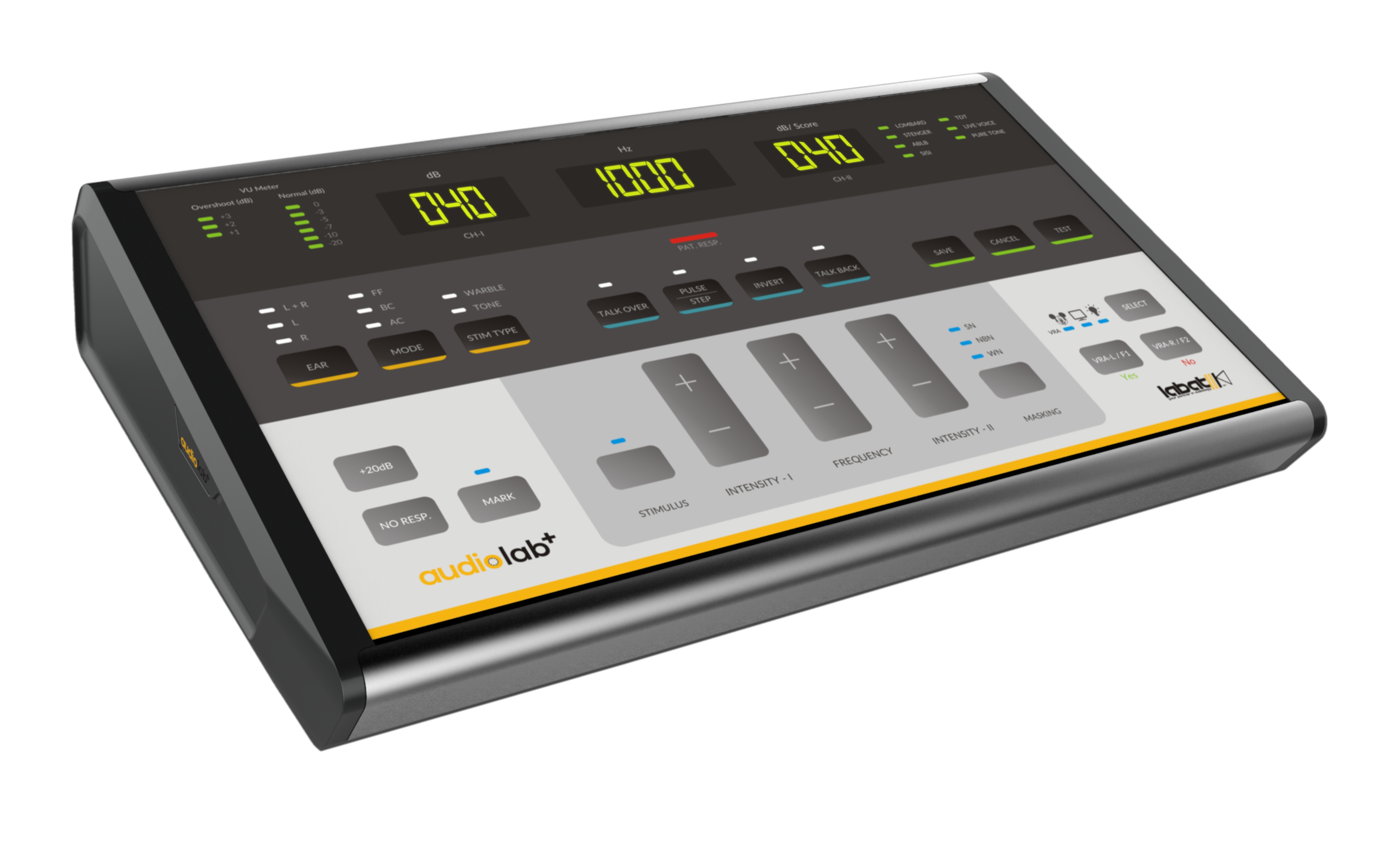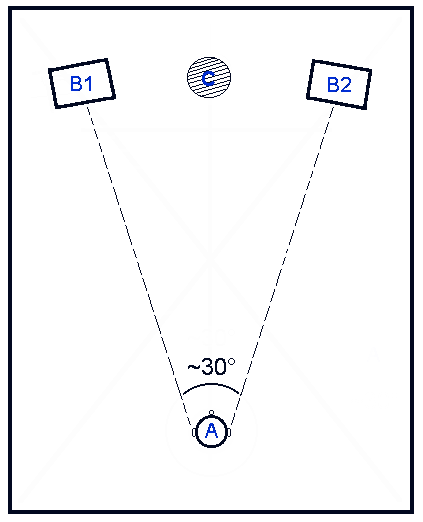|
Audiometry
Audiometry () is a branch of audiology and the science of measuring hearing acuity for variations in sound intensity and pitch and for tonal purity, involving thresholds and differing frequencies. Typically, audiometric tests determine a subject's hearing levels with the help of an audiometer, but may also measure ability to discriminate between different sound intensities, recognize pitch, or distinguish speech from background noise. Acoustic reflex and otoacoustic emissions may also be measured. Results of audiometric tests are used to diagnose hearing loss or diseases of the ear, and often make use of an audiogram. History The basic requirements of the field were to be able to produce a repeating sound, some way to attenuate the amplitude, a way to transmit the sound to the subject, and a means to record and interpret the subject's responses to the test. Mechanical "acuity meters" and tuning forks For many years there was desultory use of various devices capable of pro ... [...More Info...] [...Related Items...] OR: [Wikipedia] [Google] [Baidu] |
Pure Tone Audiometry
Pure-tone audiometry is the main hearing test used to identify hearing threshold levels of an individual, enabling determination of the degree, type and configuration of a hearing loss and thus providing a basis for diagnosis and management. Pure-tone audiometry is a subjective, behavioural measurement of a hearing threshold, as it relies on patient responses to '' pure tone'' stimuli. Therefore, pure-tone audiometry is only used on adults and children old enough to cooperate with the test procedure. As with most clinical tests, standardized calibration of the test environment, the equipment and the stimuli is needed before testing proceeds (in reference to ISO, ANSI, or other standardization body). Pure-tone audiometry only measures audibility thresholds, rather than other aspects of hearing such as sound localization and speech recognition. However, there are benefits to using pure-tone audiometry over other forms of hearing test, such as click auditory brainstem response (ABR ... [...More Info...] [...Related Items...] OR: [Wikipedia] [Google] [Baidu] |
Acoustic Reflex
The acoustic reflex (also known as the stapedius reflex, stapedial reflex, auditory reflex, middle-ear-muscle reflex (MEM reflex, MEMR), attenuation reflex, cochleostapedial reflex or intra-aural reflex) is an involuntary muscle contraction that occurs in the middle ear in response to loud sound stimuli or when the person starts to vocalize. When presented with an intense sound stimulus, the stapedius and tensor tympani muscles of the ossicles contract. The stapedius stiffens the ossicular chain by pulling the stapes (stirrup) of the middle ear away from the oval window of the cochlea and the tensor tympani muscle stiffens the ossicular chain by loading the tympanic membrane when it pulls the malleus (hammer) in toward the middle ear. The reflex decreases the transmission of vibrational energy to the cochlea, where it is converted into electrical impulses to be processed by the brain. Acoustic reflex threshold The acoustic reflex threshold (ART) is the sound pressure level (SPL) ... [...More Info...] [...Related Items...] OR: [Wikipedia] [Google] [Baidu] |
Hearing (sense)
Hearing, or auditory perception, is the ability to perceive sounds through an organ, such as an ear, by detecting vibrations as periodic changes in the pressure of a surrounding medium. The academic field concerned with hearing is auditory science. Sound may be heard through solid, liquid, or gaseous matter. It is one of the traditional five senses. Partial or total inability to hear is called hearing loss. In humans and other vertebrates, hearing is performed primarily by the auditory system: mechanical waves, known as vibrations, are detected by the ear and transduced into nerve impulses that are perceived by the brain (primarily in the temporal lobe). Like touch, audition requires sensitivity to the movement of molecules in the world outside the organism. Both hearing and touch are types of mechanosensation. Hearing mechanism There are three main components of the human auditory system: the outer ear, the middle ear, and the inner ear. Outer ear The ou ... [...More Info...] [...Related Items...] OR: [Wikipedia] [Google] [Baidu] |
Auditory Brainstem Response
The auditory brainstem response (ABR), also called brainstem evoked response audiometry (BERA), is an auditory evoked potential extracted from ongoing electrical activity in the brain and recorded via electrodes placed on the scalp. The measured recording is a series of six to seven vertex positive waves of which I through V are evaluated. These waves, labeled with Roman numerals in ''Jewett'' and ''Williston'' convention, occur in the first 10 milliseconds after onset of an auditory stimulus. The ABR is considered an ''exogenous response'' because it is dependent upon external factors. The auditory structures that generate the auditory brainstem response are believed to be as follows: *Wave I through III – generated by the auditory branch of cranial nerve VIII and lower *Wave IV and V – generated by the upper brainstem *More in depth location – wave I and II originates from the distal and proximal auditory nerve fibers, wave III from the cochlear nucleus, IV showing a ... [...More Info...] [...Related Items...] OR: [Wikipedia] [Google] [Baidu] |
Conditioned Play Audiometry
Conditioned play audiometry (CPA) is a type of audiometry done in children from ages 2 to 5 years old, in developmental age. It is the test that directly follows visual reinforcement audiometry when the child becomes able to focus on a task. It is a type of behavioral hearing test, of which there are many. Conditioned play audiometry uses toys to direct the child's attention on the listening task and turns it into a game. Instead of raising one's hand in response to the sound, as an adult would, the child might drop a toy into a bucket every time he or she hears a sound. This keeps the child interested in the listening task for longer. Common games include dropping balls in buckets, placing rings on a stick, feeding coins in a play pig, among many others. The first part of CPA involves conditioning the child. The audiologist presents a loud sound that the child can comfortably hear, while encouraging the child to "drop the ball in the bucket every time you hear the sound," or which ... [...More Info...] [...Related Items...] OR: [Wikipedia] [Google] [Baidu] |
Audiometer
An audiometer is a machine used for evaluating hearing acuity. They usually consist of an embedded hardware unit connected to a pair of headphones and a test subject feedback button, sometimes controlled by a standard PC. Such systems can also be used with bone vibrators, to test conductive hearing mechanisms. Audiometers are standard equipment at ENT (ear, nose, throat) clinics and in audiology centers. An alternative to hardware audiometers are software audiometers, which are available in many different configurations. Screening PC-based audiometers use a standard computer. Clinical PC-based audiometers are generally more expensive than software audiometers, but are much more accurate and efficient. They are most commonly used in hospitals, audiology centers and research communities. These audiometers are also used to conduct industrial audiometric testing. Some audiometers even provide a software developer's kit that provides researchers with the capability to create their ... [...More Info...] [...Related Items...] OR: [Wikipedia] [Google] [Baidu] |
Audiology
Audiology (from Latin , "to hear"; and from Greek , ''-logia'') is a branch of science that studies hearing, balance, and related disorders. Audiologists treat those with hearing loss and proactively prevent related damage. By employing various testing strategies (e.g. behavioral hearing tests, otoacoustic emission measurements, and electrophysiologic tests), audiologists aim to determine whether someone has normal sensitivity to sounds. If hearing loss is identified, audiologists determine which portions of hearing (high, middle, or low frequencies) are affected, to what degree (severity of loss), and where the lesion causing the hearing loss is found ( outer ear, middle ear, inner ear, auditory nerve and/or central nervous system). If an audiologist determines that a hearing loss or vestibular abnormality is present, they will provide recommendations for interventions or rehabilitation (e.g. hearing aids, cochlear implants, appropriate medical referrals). In addition to d ... [...More Info...] [...Related Items...] OR: [Wikipedia] [Google] [Baidu] |
Audiogram
An audiogram is a graph that shows the audible threshold for standardized frequencies as measured by an audiometer. The Y axis represents intensity measured in decibels and the X axis represents frequency measured in hertz. The threshold of hearing is plotted relative to a standardised curve that represents 'normal' hearing, in dB(HL). They are not the same as equal-loudness contours, which are a set of curves representing equal loudness at different levels, as well as at the threshold of hearing, in absolute terms measured in dB SPL (sound pressure level). Audiograms are set out with frequency in hertz (Hz) on the horizontal axis, most commonly on a logarithmic scale, and a linear dBHL scale on the vertical axis. For humans, normal hearing is between −10 dB(HL) and 15 dB(HL), although 0 dB from 250 Hz to 8 kHz is deemed to be 'average' normal hearing. Hearing thresholds of humans and other mammals can be found with behavioural hearing tests or phys ... [...More Info...] [...Related Items...] OR: [Wikipedia] [Google] [Baidu] |
Suprathreshold
{{Short pages monitor ... [...More Info...] [...Related Items...] OR: [Wikipedia] [Google] [Baidu] |
Psychoacoustic
Psychoacoustics is the branch of psychophysics involving the scientific study of sound perception and audiology—how humans perceive various sounds. More specifically, it is the branch of science studying the psychological responses associated with sound (including noise, speech, and music). Psychoacoustics is an interdisciplinary field of many areas, including psychology, acoustics, electronic engineering, physics, biology, physiology, and computer science. Background Hearing is not a purely mechanical phenomenon of wave propagation, but is also a sensory and perceptual event; in other words, when a person hears something, that something arrives at the ear as a mechanical sound wave traveling through the air, but within the ear it is transformed into neural action potentials. The outer hair cells (OHC) of a mammalian cochlea give rise to enhanced sensitivity and better frequency resolution of the mechanical response of the cochlear partition. These nerve pulses then travel to th ... [...More Info...] [...Related Items...] OR: [Wikipedia] [Google] [Baidu] |
Sound Localization
Sound localization is a listener's ability to identify the location or origin of a detected sound in direction and distance. The sound localization mechanisms of the mammalian auditory system have been extensively studied. The auditory system uses several cues for sound source localization, including time difference and level difference (or intensity difference) between the ears, and spectral information. These cues are also used by other animals, such as birds and reptiles, but there may be differences in usage, and there are also localization cues which are absent in the human auditory system, such as the effects of ear movements. Animals with the ability to localize sound have a clear evolutionary advantage. How sound reaches the brain Sound is the perceptual result of mechanical vibrations traveling through a medium such as air or water. Through the mechanisms of compression and rarefaction, sound waves travel through the air, bounce off the pinna and concha of the exter ... [...More Info...] [...Related Items...] OR: [Wikipedia] [Google] [Baidu] |






